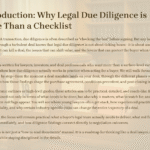To read or download the article, please click the following link.
I. Introduction
Rare earth elements are vital components in a wide range of high-tech products, from smartphones and electric vehicles to defense systems and renewable energy technologies. As global demand for these materials increases, Vietnam, with its abundant rare earth deposits, will be positioning itself as a key source for these strategic minerals.
This article will provide an overview of the legal framework for rare earth mining in Vietnam, highlighting the opportunities for investment, key regulatory requirements, and the government’s plans to expand rare earth exploration and exploitation.
II. Strategic Government Plans for Exploration and Exploitation
Vietnam’s government has set ambitious goals for the exploration and exploitation of rare earth minerals, recognizing their critical importance to both the national economy and global industries. These goals are outlined in Decision No. 866/QD-TTg (2023), which details the country’s long-term strategy for developing its rare earth resources through 2050.
The strategy focuses on both short-term and long-term objectives for the exploration and exploitation of rare earths. By 2030, Vietnam aims to complete all licensed exploration projects at key sites, including the Bac Nam Xe and Nam Nam Xe mines in Lai Chau province. The government also plans to expand exploration in other areas, such as Lao Cai and Yen Bai, and has outlined specific investment opportunities in these regions. As of July 2023, eight exploration projects are scheduled for completion by 2030, with additional projects planned for the 2031-2050 period.
On the exploitation front, the government envisions the development of an efficient, sustainable rare earth industry concentrated in the Northern Midlands and Mountains region. By 2025, licensed mining projects are expected to complete the necessary infrastructure and begin processing rare earth carbonate products with a purity of 99%. By 2030, enterprises should be engaging in deep processing activities, converting raw rare earths into oxides, hydroxides, and salts with a high total rare earth oxide (TREO) content of 95% or more. This presents significant opportunities for businesses capable of investing in the advanced technologies needed for deep processing and environmental protection.
Looking further ahead, the period from 2031 to 2050 envisions expanded mining operations and new investment projects in Lai Chau and Lao Cai, with a projected annual output of over two million tons of raw ore. The government is also keen to attract integrated investors—those involved not just in exploration and exploitation, but also in processing and marketing rare earth products globally.
III. Legal Definition of Rare Earths
In Vietnam, rare earths are classified as minerals under the country’s legal framework. According to Decision No. 866/QD-TTg dated July 18, 2023, rare earth elements are officially recognized as valuable natural resources. This classification plays a critical role in how these minerals are regulated, explored, and exploited.
Rare earths are defined broadly as minerals that naturally accumulate in solid, liquid, or gaseous forms either underground or on the surface. However, what makes them particularly unique in legal terms is their potential classification as toxic minerals. Rare earths often contain radioactive elements such as thorium and uranium, which can pose significant environmental risks during the mining and processing stages. According to guidelines from the Ministry of Natural Resources and Environment (MONRE), if the radiation levels released during mining exceed Vietnam’s strict environmental thresholds, rare earths may be treated as toxic substances, requiring special handling, containment, and oversight.
This dual classification—rare earths as both a mineral and a potential toxic substance—places additional legal responsibilities on companies interested in exploration and exploitation. Enterprises involved in rare earth projects must not only comply with mineral laws but also adhere to stringent environmental regulations, particularly those related to radiation safety and environmental protection.
IV. Key Legal Provisions on Mineral Exploration Activities
Vietnam’s regulatory framework for rare earth mineral exploration is built around the Law on Minerals 2010 and the upcoming Draft Law on Geology and Minerals 2024. These laws define the procedures, requirements, and conditions under which mineral exploration activities can be carried out in the country. Understanding these legal provisions is critical for investors and businesses interested in exploring Vietnam’s rare earth resources.
1. Licensing Requirements for Mineral Exploration
To engage in mineral exploration, businesses must first obtain a Mineral Exploration License. This license is issued by either the Ministry of Natural Resources and Environment (MONRE) or the provincial People’s Committee, depending on the project’s scope and location. The license is valid for a maximum of 48 months and may be extended multiple times, but the total extension period cannot exceed 48 months. This ensures that exploration activities are time-bound and that companies adhere to government timelines for project execution.
Only enterprises established under the Law on Enterprises, cooperatives, or foreign enterprises with representative offices or branches in Vietnam are eligible to apply for this license. In addition, enterprises must meet certain financial and technical requirements, demonstrating the capacity to carry out exploration projects in compliance with Vietnamese regulations.
2. Exploration License Conditions
A Mineral Exploration License can only be granted for areas that have not been explored or exploited by other organizations, and where the region is not classified as a prohibited or temporarily restricted zone for mineral activities. The upcoming Draft Law on Geology and Minerals 2024 expands these restrictions by adding areas that are undergoing basic geological surveys, further limiting potential exploration zones.
Another critical condition for obtaining a license is that exploration activities must be consistent with national mineral planning and any relevant provincial planning documents. The government requires that exploration projects fit within its broader resource management strategy to ensure that the country’s rare earth deposits are utilized efficiently and sustainably.
3. Environmental and Financial Responsibilities
Mineral exploration enterprises are responsible for preventing environmental pollution and must implement mitigation measures throughout the exploration process. Compliance with environmental protection regulations, such as submitting environmental impact assessments and remediation plans, is mandatory. This aligns with Vietnam’s broader commitment to sustainable development and environmental stewardship in the rare earth sector.
Furthermore, enterprises must demonstrate sufficient financial capacity to carry out the exploration project. The financial requirement is designed to ensure that only companies with adequate resources can engage in mineral exploration, thus preventing undercapitalized projects that could harm the environment or fail to meet government expectations.
4. Priority for Existing License Holders
Enterprises that have conducted mineral exploration activities are given priority when applying for exploitation licenses. This incentivizes companies to complete exploration projects and encourages long-term investment in the sector. Under the current law, companies have up to 36 months from the expiration of their exploration license to submit an application for an exploitation license for the reserves they have identified.
5. Key Differences in the Draft Law on Geology and Minerals 2024
The Draft Law on Geology and Minerals 2024 introduces some important updates to the legal framework, particularly concerning the exploration of rare earth minerals. While many provisions remain similar to the 2010 Law on Minerals, the new law simplifies some conditions for license issuance and enhances environmental protection measures. Notably, the draft law removes specific conditions for issuing exploration licenses but maintains the requirement for a thorough appraisal of the exploration project before a license is granted.
Additionally, the draft law allows for overlapping exploration licenses, meaning that a company may explore for minerals at different depths in the same area, provided this is technically feasible and approved. This provides more flexibility for companies that wish to conduct deep exploration without interfering with other ongoing activities in the same region.
6. Compliance with Atomic Energy and Environmental Protection Laws
In cases where rare earth exploration occurs in areas containing radioactive ores, companies must also comply with the Law on Atomic Energy. This includes applying for additional licenses for radioactive ore exploration and submitting safety assessments to ensure that their operations do not pose environmental or health risks. Additionally, enterprises are required to develop and implement safety protocols to prevent radiation exposure during exploration activities.
Vietnam’s Law on Environmental Protection also applies, requiring companies to submit detailed plans for environmental protection and restoration. These requirements are in place to mitigate the potentially harmful impacts of rare earth exploration, particularly in sensitive or protected areas.
V. Environmental and Safety Regulations
Environmental protection and safety are at the core of Vietnam’s legal framework for rare earth mining, and companies interested in this sector must prioritize compliance with these regulations. Given the potential environmental hazards associated with rare earth exploitation—particularly the release of radioactive elements such as thorium and uranium—the legal requirements are designed to mitigate the environmental and public health risks posed by these activities.
Vietnam’s Law on Environmental Protection mandates strict obligations for companies engaged in mineral exploration and exploitation. Enterprises must conduct environmental impact assessments (EIAs) before commencing any mining activities. These assessments are essential to evaluate the potential environmental damage and to propose appropriate mitigation measures. For large-scale projects, classified as Group I investments, the environmental impact assessment must be completed before obtaining investment policy approval. Both Group I and Group II projects must submit detailed environmental protection plans, including measures for waste management, water and air pollution control, and radiation safety.
Mining companies involved in rare earth projects must also secure an Environmental License, which is issued by the Ministry of Natural Resources and Environment (MONRE) or provincial authorities, depending on the scale of the project. This license ensures that enterprises adhere to environmental safety standards throughout the project’s lifecycle. For example, companies that generate hazardous waste exceeding certain thresholds—such as 1,200 kg per year or 100 kg per month—are required to obtain the license and comply with strict reporting requirements. These standards are especially relevant for rare earth mining, as the radioactive by-products of processing can pose significant environmental and public health risks if not properly managed.
In addition to environmental regulations, rare earth mining companies must comply with the Law on Atomic Energy, which governs the handling of radioactive materials. When rare earths are found in areas that contain radioactive ores, enterprises must apply for specific licenses related to the exploration, exploitation, and processing of these materials. The law also mandates annual safety assessments, ongoing environmental monitoring, and radiation control measures to ensure public safety. Any adverse environmental impact must be immediately addressed, and enterprises are required to carry out environmental remediation once their activities conclude.
To further enhance safety, mining projects are required to provide environmental protection deposits. These deposits serve as financial guarantees that companies will take responsibility for any environmental damage caused during the mining process. Additionally, enterprises must develop plans for environmental incident prevention and response, outlining how they will address potential emergencies such as spills, contamination, or radiation exposure.
VI. Investment Conditions for Foreign Investors
Vietnam presents promising opportunities for foreign investors in the rare earth mining sector, but it is essential to understand the regulatory framework governing foreign participation. The exploration and exploitation of minerals, including rare earths, are classified as conditional market access sectors for foreign investors, meaning that they must comply with specific legal conditions to enter the market.
Under Vietnam’s commitments to international trade agreements such as the World Trade Organization (WTO) and the Comprehensive and Progressive Agreement for Trans-Pacific Partnership (CPTPP), foreign investors are permitted to engage in certain mineral-related activities, but with restrictions. For mineral exploration, the WTO commitments allow foreign investors to establish wholly foreign-owned enterprises for geological and geophysical services, such as reserve estimation and surveying. In contrast, activities related to the exploitation of minerals are more restricted. Foreign investors may only participate in exploitation activities if they can demonstrate that their projects offer net benefits to Vietnam, such as contributing to economic development, technological advancement, or environmental protection.
In practice, this means that foreign investors looking to exploit rare earth resources must navigate a highly regulated environment. For example, foreign investors seeking to establish wholly foreign-owned enterprises in the field of mineral exploitation may face restrictions unless they can prove that their projects align with Vietnam’s strategic goals and offer substantial benefits to the local economy. This decision rests with the competent Vietnamese authorities, who will evaluate the impact of the project, including its technological contributions, environmental management plans, and its integration with Vietnam’s broader development goals.
Additionally, foreign investors should be aware of the flexibility provided under Article 17.9 of Decree 31. This provision allows investors covered by multiple international investment agreements to choose the market access conditions that best align with their business activities. For instance, if a foreign investor’s home country is a signatory to the CPTPP, they may opt to apply the CPTPP’s more favorable market access conditions, provided these align with their investment plans.
Land lease arrangements for foreign investors also present unique conditions. Under Vietnamese law, companies involved in mineral exploration or exploitation may lease land to conduct their activities. However, if the mining activities do not disturb the surface land or topsoil, a lease may not be required, offering some flexibility to investors depending on the specific nature of their project.
VI. Technological and International Cooperation Opportunities
Vietnam’s rare earth industry presents not only opportunities for resource exploitation but also for technological innovation and international cooperation. Recognizing the importance of advancing technology and aligning with global best practices, the Vietnamese government has integrated several strategic objectives into its rare earth mining policies. For investors, this creates significant opportunities to collaborate with both local entities and international partners to develop cutting-edge mining and processing techniques.
One of the key goals outlined in Decision No. 866/QD-TTg (2023) is the establishment of integrated mining complexes that combine exploration, exploitation, and processing within a single coordinated framework. These complexes are expected to utilize advanced technologies, enabling enterprises to extract and process rare earth minerals more efficiently while minimizing environmental impact. This strategy reflects the government’s vision for Vietnam to become a leader in deep processing of rare earths, moving beyond raw material extraction to the production of higher-value products such as rare earth oxides, hydroxides, and salts with high TREO (Total Rare Earth Oxides) content.
Vietnam is keen to attract foreign direct investment (FDI) that brings advanced technologies and expertise into its mining sector. The government has emphasized the importance of technology transfer from developed countries, aiming to reduce the technological gap between Vietnam and global leaders in mineral exploitation and processing. Investors with access to state-of-the-art technology and know-how in rare earth processing will find a favorable environment for collaboration. For example, enterprises involved in deep processing techniques such as separating individual rare earth elements will benefit from government incentives if they adopt environmentally friendly and resource-efficient technologies.
In addition to technological innovation, international cooperation plays a pivotal role in the development of Vietnam’s rare earth industry. The government has encouraged partnerships with foreign entities, particularly those from countries with advanced mining and environmental management practices. These collaborations are expected to enhance Vietnam’s capacity in areas such as resource management, environmental protection, and labor safety, while also improving the overall efficiency of mining operations. Moreover, Vietnam is actively promoting the exchange of knowledge in geological and mineral database management, exploration techniques, and sustainable development practices.
However, while the government is open to international partnerships, there are certain restrictions on foreign participation in rare earth mining. For example, joint ventures and associations with foreign investors are permitted, but full foreign ownership in the extraction and processing of rare earth minerals may be limited due to national security and resource management concerns. This underscores the importance of structuring foreign investments in a way that aligns with Vietnam’s strategic interests, particularly in terms of economic development and environmental sustainability.
VII. Conclusion
Vietnam’s rare earth mining sector offers significant opportunities for businesses and investors, particularly in light of global demand for these critical materials. As rare earth elements continue to play a crucial role in industries ranging from electronics to renewable energy, Vietnam’s abundant reserves position it as a key supplier in the international market.
However, success in this sector requires more than just financial investment. Companies must navigate a complex regulatory environment, comply with stringent environmental and safety standards, and align with the government’s strategic objectives for sustainable development. The legal framework governing rare earth exploration and exploitation in Vietnam reflects the country’s commitment to not only harnessing its natural resources but doing so in a way that balances economic growth with environmental protection.
Investors must also be prepared to engage with technological innovation and international cooperation opportunities. The Vietnamese government actively encourages partnerships that bring advanced technologies and expertise into the mining sector. For foreign investors, demonstrating the ability to contribute to the country’s long-term goals—whether through technology transfer, environmental stewardship, or sustainable development—will be key to securing licenses and building successful ventures.







